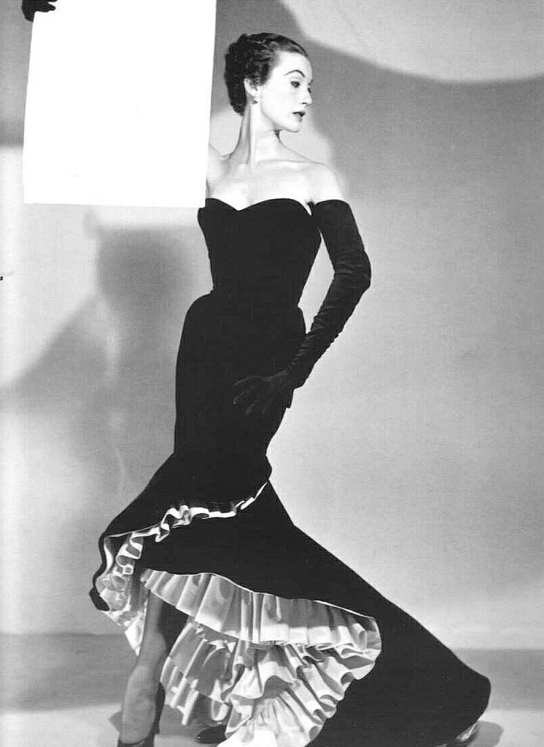I have recently become addicted (as in, I watch it every couple of days. Perhaps on repeat.) to Anna Calvi’s simple but mesmerizing video Blackout:
Though this particular video spends much time grazing Ms. Calvi’s chiseled jawline and lingering on her sensuous, down-turned red mouth (all of which I heartily approve of!), you unfortunately don’t get a concrete taste of her distinctive style, as you do in this live performance of another new favorite of mine, Desire:
Here we voyeurs can better appreciate the full ensemble: the aggressively slicked-back bun, the winged khol eyes, more of those ruby lips. In conducting a rudimentary image search of Anna, you’ll see she always dresses in strict variations of these themes: red, high-collared shirt with sharp shoulder tailoring; severe low bun; high-waisted black pants; fetish stilettos. Voila! So stringently cohesive (and effective!) is her style as a performer that when her hair is seen in loose curls, it doesn’t feel quite right. It’s a distinctly Spanish style, and though her Italian roots make it easy for her to “pass,” Calvi is not actually Spanish; however, her intense performance style (look at those knitted brows!) easily recalls those of great Flamenco singers.
Flamenco dresses are traditionally red, white and black, polka-dotted, and elaborately ruffled. The graphic qualities of all these elements effectively emphasize the motion of the dancer, as does the common use of asymmetrical or uneven ruffles which imply movement, even in moments of rest:
Fringed shawls heighten this effect, fluidly exaggerating the human motion:
The fringed flapper dresses of the 1920s borrowed the fringe and layered it over entire dresses; this was hugely informed by the popularization of athletic dances like the Charleston, which looked even more marvelous when executed by flappers draped in motion-enhancing fringe. I cannot over-emphasize how jerky these dance crazes were; see the hilarious proof yourself (around 0:26, 1:05, and 2:00, befringed women shake vigorously):
Unlike the ’20s, which was possibly the first decade youth led a widespread fashion revolution (this is, of course, the default now), an interesting characteristic of Flamenco distinguishing it from other dance forms where the nubile are strongly favored (and generally retire in middle age), youth are considered too immature to convey the emotional depth, wisdom, and pain expected of Flamenco performers, whose peaks generally start where other dancers’ end; often performing beyond their 50s. Though frilly, the weightiness of layered Flamenco dresses contribute to this gravitas.
Christian Dior made use of beading in his Flamenco-inspired dress from 1952, creating trompe l’oeil layered ruffles, even as the silhouette remained typical of the 1950’s New Look:
As the wonderful recent exhibition Balenciaga: Spanish Master at New York’s Spanish Institute pointed out, that designer frequently looked to his Spanish roots for inspiration, and many of his dresses, though perfectly indicative of the time in which they were created (puffy skirts and graphic prints were common in the ’60s), they undeniably incorporated red, polka-dots, and lots of ruffles– Flamenco trademarks. In this example, he’s flipped the ruffles to the inner layer, as petticoats (the photo doesn’t capture the vaginal pink of those semi-obscured ruffles):
The late Alexander McQueen devoted an entire collection to “The Dance of the Twisted Bull” in 2002, conflating Spanish dancing traditions with the footwork of bullfighters (not all were as literal as this example, but I happen to particularly love how the train has turned into a matador’s cape, pierced through):
Though not from the same collection (in fact, from a shipwreck-themed one collection of the following year), McQueen’s famous “Oyster Dress,” now exhibited in the Met’s spectacular Alexander McQueen: Savage Beauty, is clearly speaking from the Flamenco tradition too, with hundreds of layers of silk organza, collapsing the normally stiff ruffles into a softer, destroyed, waterlogged version…
…of a traditional Flamenco dress:
To return to Anna Calvi: her highly stylized, feminine Flamenco makeup flourishes are interestingly contradicted by (male) torero-inspired black slacks and red button-down. Balenciaga famously riffed on this cross-dressing too:
McQueen revived it, in a typically more extreme version:
Both of which seriously resemble Anna, do they not?
Looking at an example of a 21st century interpretation of the cross-dressing, bullfighter / Flamenco dancer drives the point home that we’re ripe for a widespread revival of this look, don’t you agree? May I also suggest that if you come across the opportunity, go see a live Flamenco performance. They are intense like you wouldn’t believe, and you might just get some inspiration from it.









































2 comments
nayapinner says:
Apr 10, 2013
I love the picture of flamenco dancer by Javier Suárez
Source : http://www.partedelshow.com.ar/noticia/ii-bienal-de-flamenco-de-buenos-aires-adelanto
好ããªã®ã§ã€Pinã—ã¾ã—ãŸã€‚
http://pinterest.com/nayapinner/
eniceu says:
Jun 3, 2011
What was used to puff out the trousers and/or hoes these men wore? How was it kept in place? And how did they manulipate the restrm with these layered clothes? (Was it on the order of young girls stuffing their bras w kleenex until they finally matured?) Thank you.